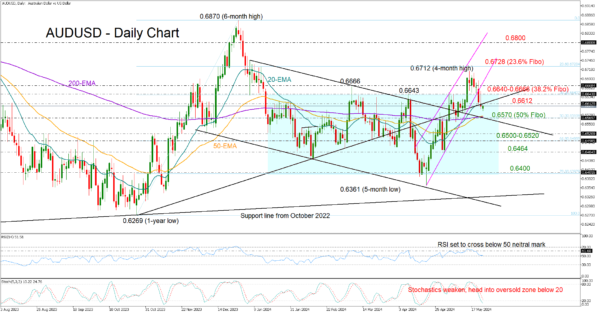- AUDUSD loses its gains above 0.6640 and falls into previous range area
- Short-term risk skewed to the downside; next support near 0.6570
- US durable goods orders and more Fed speakers on the calendar
Despite the exciting bull run to a four-month high of 0.6712 last week, AUDUSD could not sustain its gains above the 0.6640 threshold, diving back into its previous range area.
Having closed below the support trendline from April’s lows and eased slightly beneath the ascending line from October 2023 and the 20-day exponential moving average (EMA), the pair might be exposed to more selling. The technical indicators align with this narrative because the falling stochastic oscillator has not yet reached its lowest point in the oversold region, and the RSI is about to dip below its neutral mark of 50.
If the 50- and 200-day EMAs don’t serve as a safety net near the 50% Fibonacci retracement of the 0.6279-6870 uptrend at 0.6570, the price could plunge into the 0.6500-0.6520 zone, where the 61.8% Fibonacci level is located. Then, May’s low of 0.6464 could be the next target if downside pressures intensify. A decisive close below it could clear the way towards the 0.6400 mark.
To turn bullish again, the pair needs to rally above the March peak of 0.6666 and close above the broken support trendline. However, recovery attempts might be hindered by the limits at 0.6612 and 0.6640. Regardless, if the price surpasses its recent peak and exceeds the 23.6% Fibonacci level of 0.6728, it could potentially reach the psychological level of 0.6800. A continuation higher would shift all the attention to the December 2023 top of 0.6870.
Simply put, the latest downward trend in AUDUSD has breached crucial support levels, indicating an upcoming period of weakness. The sell-off is expected to gain extra impetus below the 0.6570 barrier.














